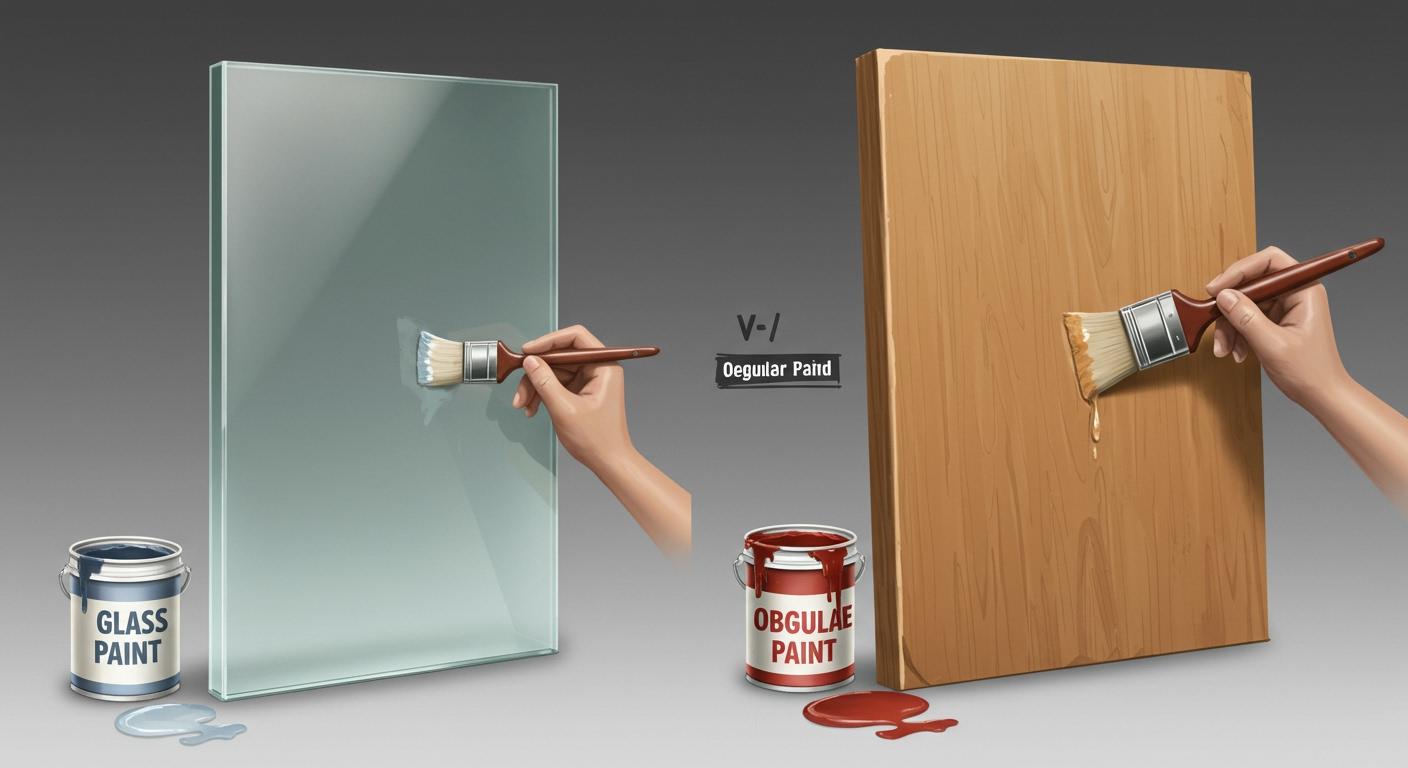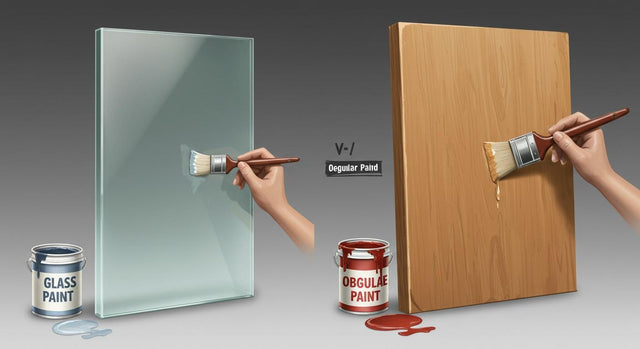What Makes Glass Paint Different from Regular Paint

Glass paint stands out because it sticks to smooth, non-porous surfaces like glass, while regular paint works best on walls or wood. You use glass paint when you want color to stay bright and clear on glass. Regular paint often peels or fades if you try to paint glass. This difference matters most when you create custom art, such as Pawimprint’s Custom Glass Portrait. Glass painting lets artists use layered and stained glass techniques to capture your pet’s personality in a striking, three-dimensional way. You can paint glass to make unique, lasting memories.
Key Takeaways
Glass paint is made for smooth surfaces like glass. It gives bright colors that last long. The paint does not peel or fade easily.
Pick glass paint for projects like custom art. This helps you get a strong finish. The colors stay bright for a long time.
Clean and degrease the glass before painting. This helps the paint stick better. It also makes the art last longer.
Use thin layers of paint for the best look. Let each layer dry before adding more. This gives a smooth and neat finish.
There are different kinds of glass paint, like enamel and acrylic. Each type has special benefits. Choose the one that fits your project best.
Glass Paint vs. Regular Paint
What Is Glass Paint?
Glass paint is made for smooth surfaces like glass. It gives bright colors and designs that last a long time. The paint does not peel or fade easily. Its special formula helps it stick well. Some glass paints, like Glassprimer™, use tiny particles to bond with glass. This changes the glass at a small level. The paint becomes part of the glass, not just on top. The finish stays clear and bright for many years.
Many industries use glass painting. You can see it on car windows, buildings, furniture, and electronics. Artists use glass paint for stained glass and custom art. Pawimprint’s Custom Glass Portrait is one example. Artists paint on acrylic glass and layer colors. This shows every detail of your pet. The painting looks 3D and stays beautiful and strong.
Tip: Always pick paint made for glass if you want your art to last and look good.
What Is Regular Paint?
Regular paint is for walls, wood, or metal. People use it to decorate rooms, furniture, or things outside. It has binders that help it stick to rough surfaces. If you use it on glass, it does not stick well. The paint can peel, chip, or fade. Glass is too smooth for regular paint. Regular paint dries in the air or with sealants. It does not need special baking.
Key Differences
You should know the main ways glass paint and regular paint are different. Here are the key points:
Adhesion: Glass paint uses tiny technology to bond with glass. It becomes part of the glass. Regular paint does not stick well and peels off.
Durability: Glass paint lasts longer on glass. Some types stay bright for years. Others may get brittle after five years. Thicker paint lasts longer, even in sunlight. Regular paint does not last on glass and fades fast.
Curing Process: Glass paint often needs baking in an oven. This helps it bond to the glass. Regular paint dries in the air or with sealants. Baking is best for glass you use with food.
Ingredients: Glass paint has special things added to help it stick and stay flexible. Here is a table with some common ingredients:
Additive Type |
Examples |
|---|---|
Coalescing agents |
Various coalescing agents used in paint formulations. |
Cosolvents |
Solvents that help in the mixing of paint components. |
Surfactants |
Agents that reduce surface tension, aiding in application. |
Buffers |
Compounds that help maintain pH levels in the formulation. |
Neutralizers |
Agents that neutralize acidity or alkalinity in the paint. |
Thickeners |
Substances that increase the viscosity of the paint. |
Non-thickening rheology modifiers |
Modifiers that adjust the flow properties without thickening. |
Dispersants |
Agents that help in the dispersion of pigments. |
Humectants |
Compounds that retain moisture in the paint. |
Wetting agents |
Agents that improve the wetting of surfaces by the paint. |
Mildewcides |
Chemicals that prevent the growth of mildew. |
Biocides |
Agents that kill or inhibit the growth of harmful organisms. |
Plasticizers |
Additives that increase the flexibility of the paint. |
Antifoaming agents |
Substances that reduce or prevent foam formation. |
Defoaming agents |
Agents that eliminate foam in the paint. |
Anti-skinning agents |
Compounds that prevent the formation of a skin on the paint surface. |
Flowing agents |
Additives that improve the flow properties of the paint. |
Anti-oxidants |
Substances that prevent oxidation of the paint components. |
Testing and Measurement: You can test glass paint for hardness and how well it sticks. Tests include pencil hardness, cross-hatch tape, and scrape adhesion. These show if the paint resists scratches and stays on the glass.
Applications: Glass paint is used in cars, buildings, furniture, electronics, and art. Regular paint is mostly for walls, wood, and metal.
If you want to paint glass and make something special, like Pawimprint’s Custom Glass Portrait, use glass paint. You will get a strong finish and a pretty result that lasts.
Types of Paint for Glass
When you want to paint glass, you must pick the right paint. There are many kinds of paint for glass. Each type works best for different things. Some brands are more popular than others. Here is a table that shows how much of the market each brand has:
Product Type |
Market Share (%) |
|---|---|
Ferro Corporation |
15 |
The Sherwin-Williams Company |
10 |
Nippon Sheet Glass Co., Ltd. |
8 |
P.P.G. Industries, Inc. |
7 |
Vitro, S.A.B. de C.V. |
5 |
Guardian Glass, L.L.C. |
4 |
Sisecam Group |
3 |

Water-Based Glass Paint
Thick water-based glass paint is good for peel-off art. Flowing water-based glass paint works for most glass art. These paints are safe and easy to wash off. You can clean them with soap and water. They help you make bright and clear art. Artists use them for custom portraits, like Pawimprint’s glass painting. Here are some good and bad things about water-based glass paint:
Advantages of Water-Based Glass Paint |
Disadvantages of Water-Based Glass Paint |
|---|---|
Takes longer to dry than other paints |
|
Safe for people and easy to clean up |
Hard to ship in cold weather |
Many ways to use it |
N/A |
Can help earn LEED points |
N/A |
Tip: Water-based paints are best for inside jobs and for artists who want easy cleaning.
Enamel-Based Glass Paint
Enamel paint gives a shiny and strong finish. It is good for glass art that needs to last outside or in tough places. Liquid enamel paint has oils, resins, and colors. Powdered enamel uses metal oxides and glass parts. Both types fight scratches, heat, and water. You can brush, spray, or roll liquid enamel. Powdered enamel needs high heat to stick to glass. Many artists use enamel for building panels and outdoor furniture.
Liquid Enamel Paint |
Powdered Enamel Coatings |
|
|---|---|---|
What it’s made of |
White spirit, white lead, colors, oils, resin |
Metal oxides, glass parts, other materials |
Finish |
Shiny, tough, keeps color, fights scratches and heat |
Hard, waterproof, glass-like, shiny or semi-shiny |
How to use |
Brush, spray, or roll |
Needs high heat to stick |
How long it lasts |
Makes a hard surface, fights sun, water, and heat |
Makes a strong, glass-like cover |
What it’s for |
Good for many glass uses |
Used for building panels and outdoor furniture |
Acrylic Paint for Glass
Acrylic paint for glass gives bright and bold colors. You can use it on windows, glasses, mirrors, or for custom art. Acrylic glass paint is safe and simple to use. It works on many surfaces. You can make it last longer by sealing or baking it. Some brands need you to bake the paint at certain heat and time:
Brand/Color |
Curing Temperature |
Curing Time |
|---|---|---|
Pebeo Vitrea 160, Color #66 Silver |
325°F |
40 minutes |
Pebeo Vitrea 160, Color #07 Amaranthine |
325°F |
40 minutes |
Pebeo Vitrea 160, Color #11 Turquoise |
325°F |
40 minutes |
Marabu Glas, Color #223 Blackberry |
320°F |
30 minutes or dry for 3 days |
Plaid FolkArt Enamel, Color #4142 Perfect Purple |
350°F |
30 minutes or dry for 21 days |
DecoArt Americana Crystal Gloss Enamels, Color #DAGT08 Purple |
275°F |
30 minutes after 4 days drying |
DecoArt Americana Gloss Enamels, Color #MDAG34 Lavender |
325°F |
30 minutes after 4 days drying |

Here are some good things about acrylic paint for glass:
Colors stay bright and bold.
The finish lasts and does not chip.
You can use it on many glass things.
It is safe and easy to clean.
Note: If you want a custom glass portrait, like Pawimprint’s, acrylic paint for glass will give you strong color and beauty that lasts.
Glass Painting Techniques

How to Paint Glass
You can create beautiful art when you learn how to paint glass. Start by choosing the right glass paint for your project. Use a clean, dry surface for the best results. If you want to achieve a 3D effect, try painting on several layers of glass. This method adds depth and makes your artwork stand out. Artists at Pawimprint use this approach for custom glass painting projects, layering colors to capture every detail. You can also use stencils or freehand designs to make your work unique. Remember to let each layer dry before adding the next one.
Preparing Glass Surfaces
Proper preparation helps your paint stick and last longer. Follow these steps before you begin any glass painting projects:
Rinse with clean water and dry the surface completely.
Degrease the glass using vinegar, alcohol, or a professional cleaner like DuraSlic Glass Prep & Panel Wipe. This removes oils and leaves no residue.
Lightly sand the surface with fine-grit sandpaper to create a slight roughness.
Make sure the glass is dust-free and dry before you start to paint on glass.
Tip: A well-prepared surface helps glass paint bond better and keeps your art looking bright for years.
Application Tips
When working with glass paint, use thin, even coats for the best finish. Apply several layers instead of one thick coat. This technique prevents drips and helps the paint dry smoothly. For 3D effects, paint on different layers of glass and stack them. This creates shadows and highlights, making your glass painting look lively. Always let each coat dry fully before adding another. If you want your art to last, consider sealing or baking your finished piece. These glass painting techniques help you create strong, lasting results, just like the artists at Pawimprint do with their custom portraits.
Note: Practice makes perfect. Try different glass painting techniques to find what works best for your style and project.
Paint Comparison
Adhesion and Durability
When you pick paint for glass, check how well it sticks. Also, see how long it lasts. Here is a table that shows how each type works on glass:
Paint Type |
Adhesion Characteristics |
Durability Characteristics |
|---|---|---|
Enamel Paints |
Good adhesion, resistant to moisture |
Long-lasting, keeps color in sunlight and harsh weather |
Oil-Based Paints |
Excellent adhesion, does not chip or peel easily |
Highly durable, can be applied thick for texture |
Specialized Glass Paints |
Superior adhesion, made for glass surfaces |
Vibrant colors, resists UV rays and tough conditions |
Enamel paints stick well to glass. They do not wash away in water. Their color stays bright in the sun. Oil-based paints cover glass with strong color. They do not peel or chip. They take longer to dry than other paints. Specialized glass paint is best for glass art. It gives bright colors and lasts a long time.
Visual Effects
You can make cool effects with different paints for glass. Enamel paint gives a shiny look that stands out. Acrylic paint for glass lets you make see-through art. Glass paint markers help you draw thin lines and details. Solvent-based paints can look clear or solid. You can pick the style you like.
Here are some effects you can make:
Enamel paint gives shiny, bold colors.
Glass painting can look layered and 3D, like Pawimprint’s portraits.
Acrylic paint for glass makes smooth color changes and soft edges.
Glass paint markers make strong lines and patterns.
Tip: Try using layers or mixing finishes to make your glass art special.
Choosing the Right Paint
Think about a few things before you start painting glass. Ask yourself these questions:
How long do you want your art to last?
Do you want a shiny or flat finish?
What kind of glass will you paint?
What color and texture does your glass have?
How much do you know about painting?
Here is a table with good and bad things about each paint for glass art:
Type of Paint |
Pros |
Cons |
|---|---|---|
Enamel Paints |
Works on many things, covers well, looks solid. |
Some brands are not sold anymore. |
Acrylic Paints for Glass |
See-through, easy to use, lets you be creative. |
Needs heat to last longer. |
Glass Paint Markers |
Makes strong lines, safe for dishwashers. |
Not many colors to pick from. |
Solvent-Based Paints |
Bright colors, can be clear or solid. |
Needs special cleaner to wash up. |
Glass paint sticks best and gives bright color. Enamel paint is good for a strong, shiny look. Acrylic paint for glass helps you make layers and easy designs. Pick the paint that fits your project and what you know how to do.
You now know that glass paint works best for smooth surfaces and gives you long-lasting, bright results. Regular paint does not stick well to glass and fades quickly. When you start a glass painting project, always choose the right paint for your needs. If you want custom art that lasts, like Pawimprint’s Custom Glass Portrait, pick paint made for glass. This choice helps your artwork stay beautiful for years.
FAQ
What makes glass paint stick to glass?
Glass paint uses special ingredients that help it bond to smooth surfaces. These ingredients create a strong grip, so the paint does not peel or chip. You get bright colors that last for years.
Can you use regular paint on glass?
You should not use regular paint on glass. It does not stick well. The paint will peel or fade quickly. Always choose paint made for glass if you want your project to last.
How do you make glass paint last longer?
You can make glass paint last longer by cleaning the glass before painting. Use thin layers and let each layer dry. For extra strength, bake the painted glass if the paint instructions allow it.
Is glass paint safe for items you use every day?
Most glass paints are safe for decorative items. If you want to paint dishes or glasses, check the label. Some paints need baking to become food-safe. Always follow the manufacturer’s instructions.

